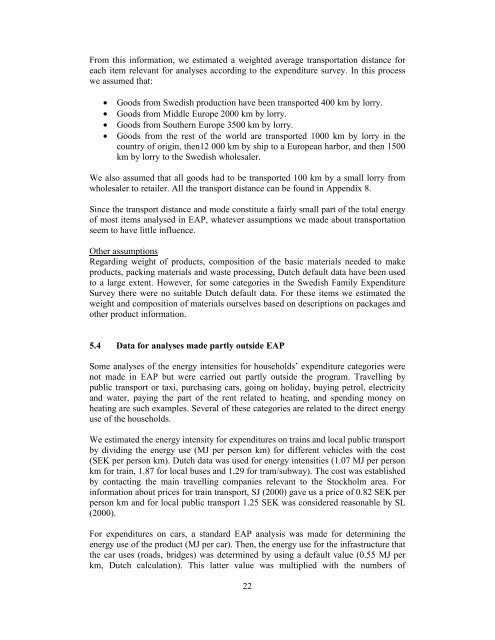Household Metabolism in the Five Cities.
Household Metabolism in the Five Cities.
Household Metabolism in the Five Cities.
Create successful ePaper yourself
Turn your PDF publications into a flip-book with our unique Google optimized e-Paper software.
From this <strong>in</strong>formation, we estimated a weighted average transportation distance for<br />
each item relevant for analyses accord<strong>in</strong>g to <strong>the</strong> expenditure survey. In this process<br />
we assumed that:<br />
• Goods from Swedish production have been transported 400 km by lorry.<br />
• Goods from Middle Europe 2000 km by lorry.<br />
• Goods from Sou<strong>the</strong>rn Europe 3500 km by lorry.<br />
• Goods from <strong>the</strong> rest of <strong>the</strong> world are transported 1000 km by lorry <strong>in</strong> <strong>the</strong><br />
country of orig<strong>in</strong>, <strong>the</strong>n12 000 km by ship to a European harbor, and <strong>the</strong>n 1500<br />
km by lorry to <strong>the</strong> Swedish wholesaler.<br />
We also assumed that all goods had to be transported 100 km by a small lorry from<br />
wholesaler to retailer. All <strong>the</strong> transport distance can be found <strong>in</strong> Appendix 8.<br />
S<strong>in</strong>ce <strong>the</strong> transport distance and mode constitute a fairly small part of <strong>the</strong> total energy<br />
of most items analysed <strong>in</strong> EAP, whatever assumptions we made about transportation<br />
seem to have little <strong>in</strong>fluence.<br />
O<strong>the</strong>r assumptions<br />
Regard<strong>in</strong>g weight of products, composition of <strong>the</strong> basic materials needed to make<br />
products, pack<strong>in</strong>g materials and waste process<strong>in</strong>g, Dutch default data have been used<br />
to a large extent. However, for some categories <strong>in</strong> <strong>the</strong> Swedish Family Expenditure<br />
Survey <strong>the</strong>re were no suitable Dutch default data. For <strong>the</strong>se items we estimated <strong>the</strong><br />
weight and composition of materials ourselves based on descriptions on packages and<br />
o<strong>the</strong>r product <strong>in</strong>formation.<br />
5.4 Data for analyses made partly outside EAP<br />
Some analyses of <strong>the</strong> energy <strong>in</strong>tensities for households’ expenditure categories were<br />
not made <strong>in</strong> EAP but were carried out partly outside <strong>the</strong> program. Travell<strong>in</strong>g by<br />
public transport or taxi, purchas<strong>in</strong>g cars, go<strong>in</strong>g on holiday, buy<strong>in</strong>g petrol, electricity<br />
and water, pay<strong>in</strong>g <strong>the</strong> part of <strong>the</strong> rent related to heat<strong>in</strong>g, and spend<strong>in</strong>g money on<br />
heat<strong>in</strong>g are such examples. Several of <strong>the</strong>se categories are related to <strong>the</strong> direct energy<br />
use of <strong>the</strong> households.<br />
We estimated <strong>the</strong> energy <strong>in</strong>tensity for expenditures on tra<strong>in</strong>s and local public transport<br />
by divid<strong>in</strong>g <strong>the</strong> energy use (MJ per person km) for different vehicles with <strong>the</strong> cost<br />
(SEK per person km). Dutch data was used for energy <strong>in</strong>tensities (1.07 MJ per person<br />
km for tra<strong>in</strong>, 1.87 for local buses and 1.29 for tram/subway). The cost was established<br />
by contact<strong>in</strong>g <strong>the</strong> ma<strong>in</strong> travell<strong>in</strong>g companies relevant to <strong>the</strong> Stockholm area. For<br />
<strong>in</strong>formation about prices for tra<strong>in</strong> transport, SJ (2000) gave us a price of 0.82 SEK per<br />
person km and for local public transport 1.25 SEK was considered reasonable by SL<br />
(2000).<br />
For expenditures on cars, a standard EAP analysis was made for determ<strong>in</strong><strong>in</strong>g <strong>the</strong><br />
energy use of <strong>the</strong> product (MJ per car). Then, <strong>the</strong> energy use for <strong>the</strong> <strong>in</strong>frastructure that<br />
<strong>the</strong> car uses (roads, bridges) was determ<strong>in</strong>ed by us<strong>in</strong>g a default value (0.55 MJ per<br />
km, Dutch calculation). This latter value was multiplied with <strong>the</strong> numbers of<br />
22
















